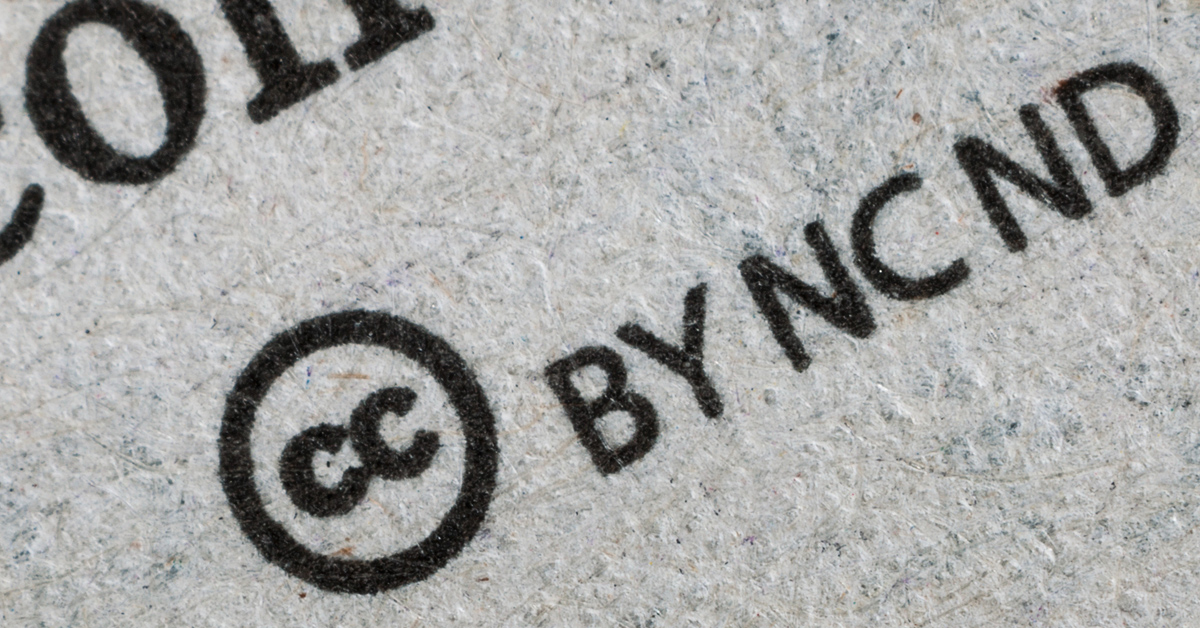Your essential guide to the six Creative Commons licenses
20/01/2022

Have you ever noticed the Creative Commons (CC) logo on a publication and wondered what it means? Perhaps you’ve been asked to choose a Creative Commons license by a publisher, but haven’t been sure about what you’re agreeing to, and what the implications are. If you recognise yourself in either of these scenarios read on! This blog post spells out in simple language what the licenses mean for you not only as a creator, but also as a user of content.
A quick look at the Creative Commons website tells me that two billion items now have a CC license. You can apply the licenses to any work that you create – not just research articles. So, for example photographs, slideshows, and videos can all be given a license. They give creators an easy, standard way of granting public permission to use their work under copyright law, as long as they abide by specific conditions. You don’t have to do anything special to add a license to your work, just add the appropriate CC logo it.
It’s very important that you know your funder’s policy requirements regarding licensing any publications you produce arising from their funding. You can see the EPSRC’s requirements here. At the time of writing you are expected to make the work openly and freely accessible via the gold route using a CC-BY license (the most open license) OR make the author accepted manuscript openly available in a repository using a license which doesn’t limit non-commercial reuse (the green route to open access). You can find more information about open access routes on our web pages.
All the licenses require the user to provide attribution – in other words, people can only make use of the work if they acknowledge the original work.
There are six licenses to choose from, and they are explained in full on the CC website. I will give you a simplified version here. Each license is made up of a series of letters which tell the user what they can and can’t do with the work, and these are also incorporated into a logo which appears on the work. Here are the six licenses – starting with the most open license, moving down to the most restrictive. I have taken this text from the Creative Commons website , and I can reuse it because the site has been given a CC-BY license. I acknowledge it fully at the end of this blogpost.
CC BY: This license allows reusers to distribute, remix, adapt, and build upon the material in any medium or format, so long as attribution is given to the creator. The license allows for commercial use.

CC BY includes the following elements:
BY – Credit must be given to the creator
CC BY-SA: This license allows reusers to distribute, remix, adapt, and build upon the material in any medium or format, so long as attribution is given to the creator. The license allows for commercial use. If you remix, adapt, or build upon the material, you must license the modified material under identical terms.

CC BY-SA includes the following elements:
BY – Credit must be given to the creator
SA – Adaptations must be shared under the same terms
CC BY-NC: This license allows reusers to distribute, remix, adapt, and build upon the material in any medium or format for non-commercial purposes only, and only so long as attribution is given to the creator.

It includes the following elements:
BY – Credit must be given to the creator
NC – Only non-commercial uses of the work are permitted
CC BY-NC-SA: This license allows reusers to distribute, remix, adapt, and build upon the material in any medium or format for non-commercial purposes only, and only so long as attribution is given to the creator. If you remix, adapt, or build upon the material, you must license the modified material under identical terms.

CC BY-NC-SA includes the following elements:
BY – Credit must be given to the creator
NC – Only non-commercial uses of the work are permitted
SA – Adaptations must be shared under the same terms
CC BY-ND: This license allows reusers to copy and distribute the material in any medium or format in unadapted form only, and only so long as attribution is given to the creator. The license allows for commercial use.

CC BY-ND includes the following elements:
BY – Credit must be given to the creator
ND – No derivatives or adaptations of the work are permitted
CC BY-NC-ND: This license allows reusers to copy and distribute the material in any medium or format in unadapted form only, for non-commercial purposes only, and only so long as attribution is given to the creator.

CC BY-NC-ND includes the following elements:
BY – Credit must be given to the creator
NC – Only non-commercial uses of the work are permitted
ND – No derivatives or adaptations of the work are permitted
Commercial use is defined as “primarily intended for or directed towards commercial advantage or monetary compensation”.
This blog post was written using material from the Creative Commons website under a CC-BY license, and the ‘Creative Commons, the 5Rs, and OER’ PowerPoint slides created by David Wiley, Lumen Learning under a CC-BY license. I hope you found it useful – please do get in touch with your research support information specialist if you have any questions. I will also use this opportunity to plug our ‘Shut up and write’ sessions. These are very informal online sessions which take place over Teams. They last about 95 minutes and include three 25-minute focused quiet writing segments – they are a great way of ensuring that you get your head down and write, with no excuses! I attended just one session to write the text for this blog post.
Categories & Tags:
Leave a comment on this post:
You might also like…
Automotive Engineering: From student to hypercar innovation at Rimac
We sat down with recent graduate Thomas Perrin, to discuss how his year on the MSc in Automotive Engineering at Cranfield University propelled him from the lecture hall directly into the ...
What this year at Cranfield really meant to me
Every Cranfield journey is unique. In this alumni reflection, Zachea Scicluna shares what her year at Cranfield truly meant, from facing uncertainty to gaining hands-on experience in industry-backed projects. I’ve been reflecting (and delaying) ...
Preparing for assignments and exams?
Sorry! We know it seems a bit mean to mention the exams in January rather than looking forward to the break before it! However, we know many of you will be thinking about your forthcoming ...
Screening for FTSE 100 companies on Bloomberg
So you’re researching an index and need some data on its constituent companies? Bloomberg’s Equity Screening tool makes light work of this, not just for the FTSE, but for indices, exchanges and sectors worldwide. Type EQS ...
Accelerating my future: How Cranfield put me on the fast track to automotive safety innovation
Hello! I’m Michaela Kaiser, and I’m thrilled to share my journey studying abroad. I’m from Calgary, Canada, and I recently graduated from Cranfield’s MSc Automotive Engineering course. My path to Cranfield ...
From Myanmar to Cranfield: My path to Renewable Energy
As someone who is passionate about sustainability, my career goal is to build a path in the renewable energy sector. My aspirations comes from the benefits of developing sustainable energy sources and ensuring energy ...






